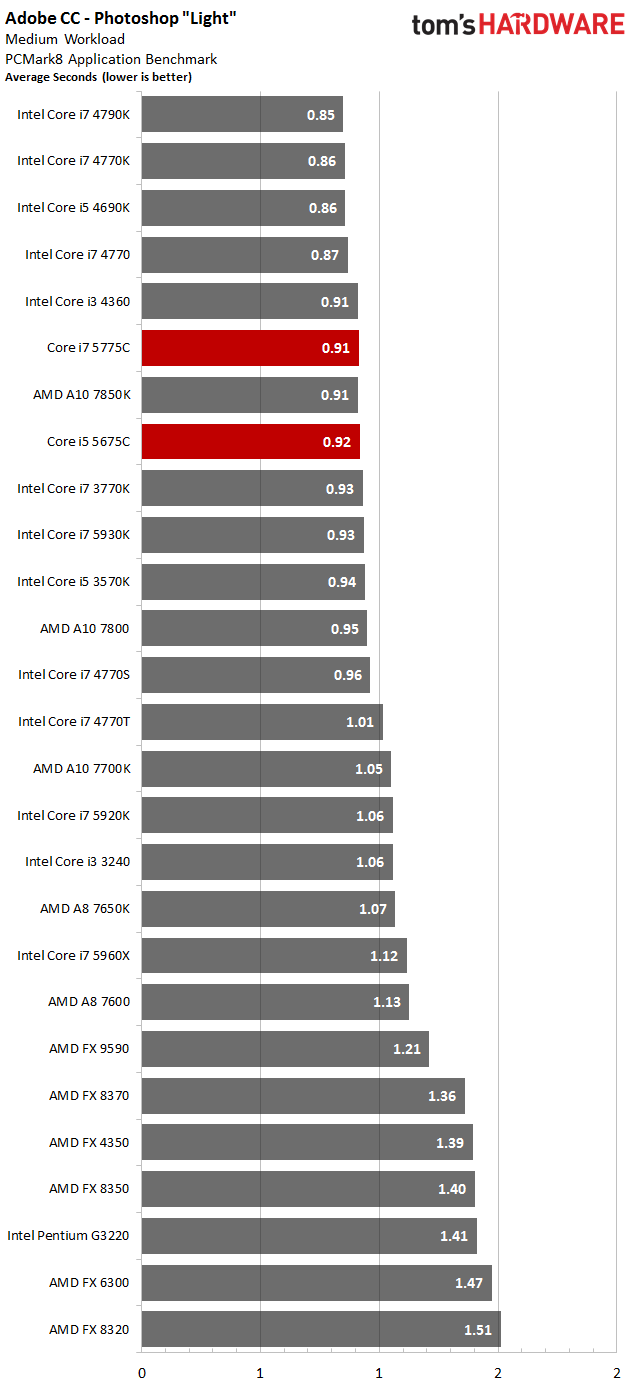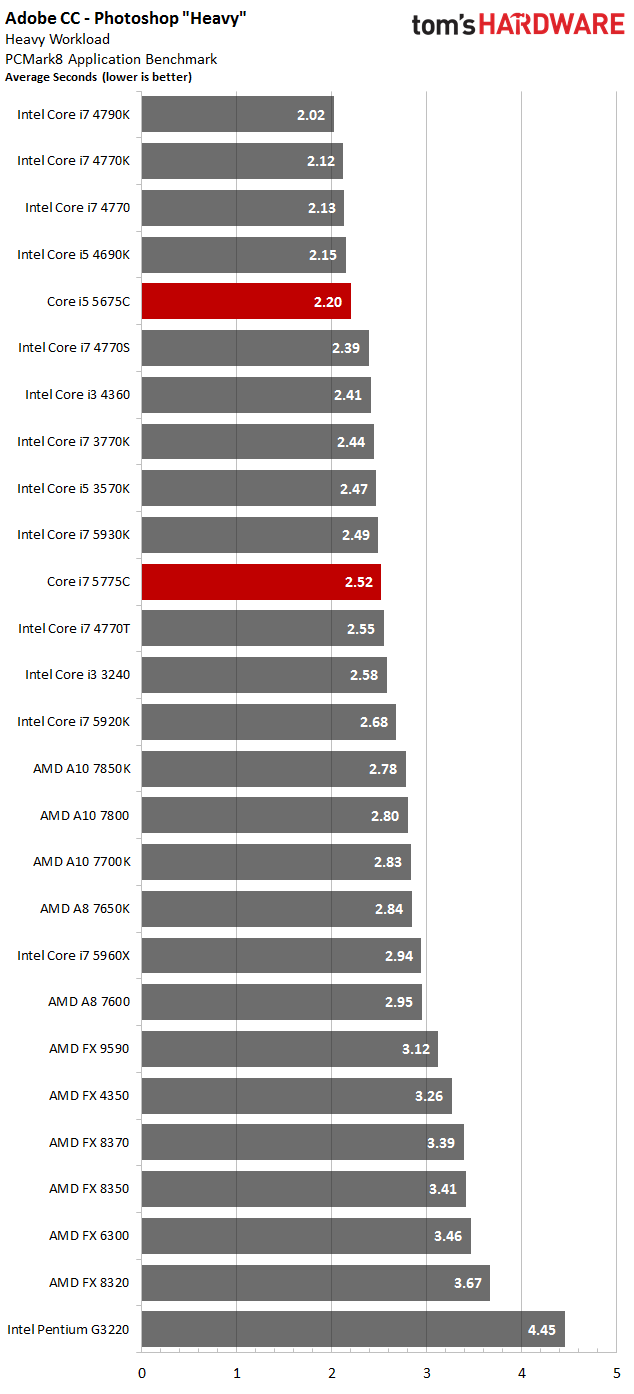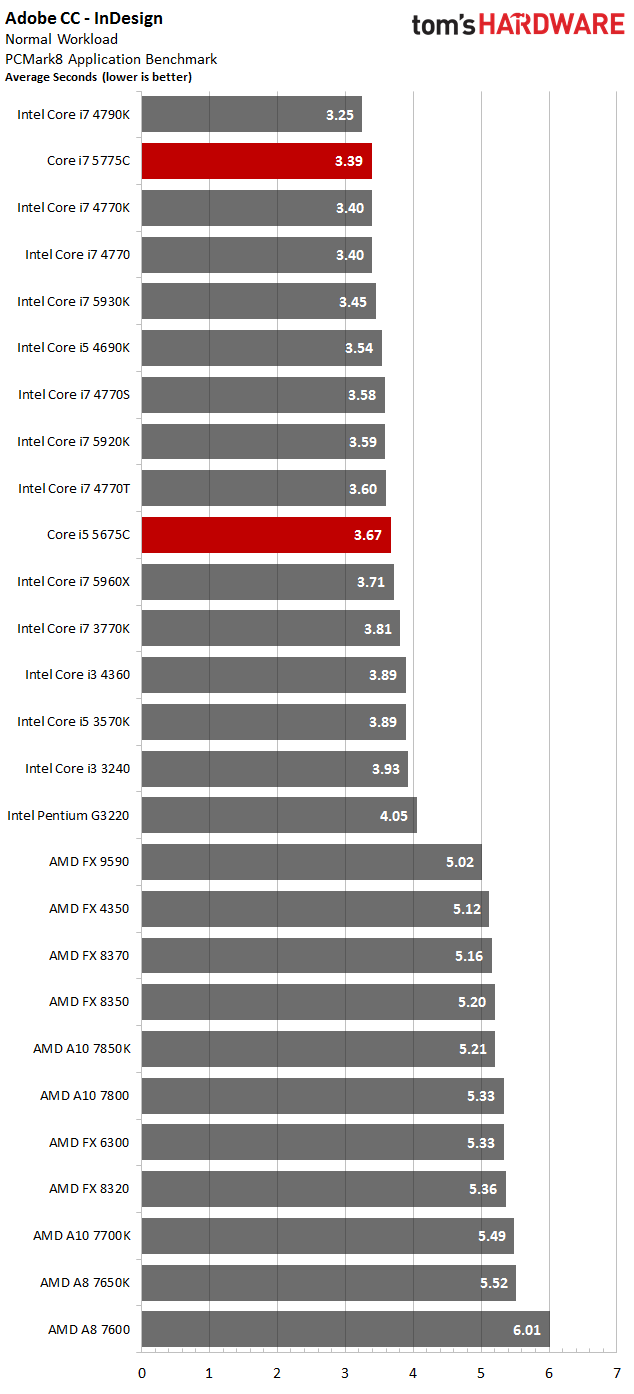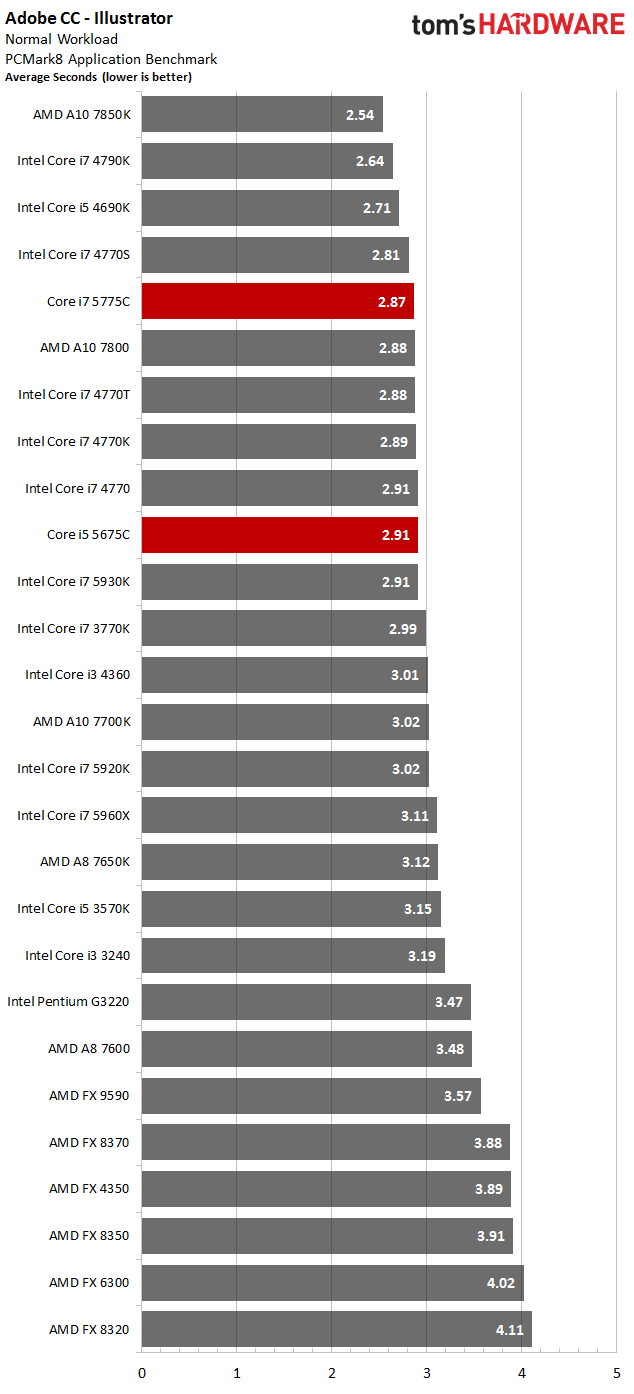Broadwell: Intel Core i7-5775C And i5-5675C Review
Desktop Publishing And Multimedia
Adobe CC
We’re using Photoshop, InDesign and Illustrator, all of which are included in Adobe’s CC package, as well as PCMark 8 Professional to control the workloads. This way, we’re covering a relatively a large range. The details of each benchmark are available in the table below.
The storage subsystem and background processes influence the benchmark results, since they include opening and closing each application, as well as loading and saving files. For this reason, PCMark 8 natively reports back the geometric mean of three benchmark trials (GEOMEAN).
Adobe Photoshop Light
| Header Cell - Column 0 | Pictures | File Size | Picture Size |
|---|---|---|---|
| Source | 14 | 3.9 to 17.6MB | 2500x16776048x4032 |
| Target | 14 | 388 to 778KB | 1200x800 |
| Actions | - Start Application and Load Data File- Change Color Balance- Add Auto Level- Adjust Shadows and Glare- Downscale with Bicubic Interpolation- Compute and Add Unsharp Mask- Save Results in Files and Close Application |
Adobe Photoshop Heavy
| Header Cell - Column 0 | File Size | Picture Size | Resolution | Layer |
|---|---|---|---|---|
| Source PSD | 113MB | 5184x7744 | 300 DPI | 1 |
| PSD Export | 1320MB | 7000x10457 | 300 DPI | 4 |
| TIFF Export | 476MB | 7000x10457 | 300 DPI | None |
| JPEG Export | 177KB | 1000x1494 | 300 DPI | None |
| Actions | - Start Application and Load PSD File- Upscale with Bicubic Interpolation- Change Color Depth to 16-bit per Channel- Create Color Range and Copy to New Layer- Merge Two Picture Layers and Insert as New Layer in Front- Compute and Add Unsharp Mask to this Foreground Layer- Create and Delete Elliptical Selection in this Layer- Merge All Layers into One Layer- Add Gaussian Blur- Add and Delete Gradient Mask- Decrease Layer's Opacity- Export File to PSD, TIFF and JPEG- Flatten Picture and Downscale with Bicubic Interpolation- Compute and Add Unsharp Mask- Export as JPEG and Close Application |
Adobe InDesign
| Header Cell - Column 0 | File Size | Pages | Pictures |
|---|---|---|---|
| Source File | 385MB | 40 | 42 |
| Target File | 378MB | 40 | 40 |
| PDF Export | 64.7MB | 40 | 40 |
| Actions | - Start Application and Load Data File- Change Picture Size and Reposition Pictures- Add Colored Rectangle as Decorative Element- Change Border Settings- Insert Text- Save Document as New File- Export as PDF File and Close Application |
Adobe Illustrator
| Header Cell - Column 0 | Original File | Saved File | Exported PDF |
|---|---|---|---|
| File | 733KB | 6.2MB | 5.6MB |
| Actions | - Start Application and Load Data File- Change Picture Sizes and Reposition Pictures- Add Translucent Filled Rectangle for Color Effect- Vectorize Pictures in Document- Add Text Fields, Lines, Rectangles, Ellipses, and Spines- Save the Documents in a New File- Export as PDF- Close Document and Application |
Bottom Line
Both Broadwell-based processors fall in line with their Haswell predecessors according to clock rate. The only notable exception is Adobe InDesign, where somewhat higher FP64 performance, including better scaling across multiple threads, sways the results upward a bit. It’s also interesting to see that AMD’s APUs fare well. They're even significantly better than the aging FX family in some places.
Get Tom's Hardware's best news and in-depth reviews, straight to your inbox.
Current page: Desktop Publishing And Multimedia
Prev Page Iris Pro Graphics 6200: Workstation Next Page Office Productivity-
RNOblivion Proof read your articles. This seems to be an increasing prevalent theme of Tom's over the last couple years.Reply -
greghome are these numbers real?.............Not only does it match lower mid range cards, but it completely destorys AMD's APUs........Reply
:shock: -
Nuckles_56 With the Sandra 2015 benchmark on the first page, you are testing the i7 7557c against the i7 4790k instead of the i7 5775cReply -
babernet_1 Sad how AMD is absolutely shoved into the dust bin. I hope their upcoming Zen next year will be worthwhile with its 14nm process and more Intel-like cores.Reply
-
wtfxxxgp This is exactly what I said to a buddy of mine about a month ago. Everyone is going on about how little Intel has done with CPUs over the past few years - presumably due to no real competition from AMD. Then people starting looking to Zen as being the real competitor for Intel and saying things like "Intel are in for a shock" - I had the view that Intel weren't resting on their laurels all this time - they've just been biding their time and doing amazing things in a hush hush manner. When Zen is released it will soon be completely obliterated by some of the tech that Intel would have been working on in the meantime - AMD has lagged too far behind for too long and love them or hate them, Intel is the benchmark when it comes to CPUs - period. They own this space, and these 2 chips have just rendered AMD APUs completely useless now. I'd be interested in this for a HTPC solution with some light gaming - League of Legends etc. This is impressive, however, like the article concluded, what a poor time for them to be released.Reply -
Grognak Wow. 93% better average framerate in GTA V than a 7850K with DDR3-2400 RAM... And that's just the i5. Incredible.Reply -
shrapnel_indie Since Broadwell is unlocked, would have been interesting to see how they overclocked. Yeah Skylake is breathing down the neck of Broadwell now thanks to the delays it suffered... but still would be fun to see.Reply
You’ve waited this long—why not hang tight for a few months for Skylake and start anew with 100-series chipsets, DDR4 and the return of unlocked 95W K-series CPUs?
Last I heard Skylake was supposed to support DDR3 and DDR4. Was that just a rumor that wasn't the truth or will it actually support DDR3 as well?
-
alpha27 heh iris coming close to a 750gtx 500 cuda core NVidia better watch out heyReply
hmm if intel whacked a few iris's on a gfx chip and did there thing they could possibly beat NVidia...and make even more money lol, hmm mutli 128mb ring buses and iris core's and hbm...delicious -
de5_Roy it's a good review. two big reviews back to back, nice job. :)Reply
i missed some things:
unlocked broadwells but no o.c. not even a little look into how these overclock and behave o.c.ed.
no comparison (gaming, power use, htpc etc.) with the desktop haswell i5 and i7 -R cpus' iris pro igpus. the amd comparisons were good though. i hope you guys test these against the haswell iris pro later.
in some of the charts, the core i7 5775 was written as i7 7557.
in the test setup page, system memory section, is it "transcend" instead of "transcent"?
edit:
one last thing: do these unlocked broadwell cpus really have 16x gen 3.0 lanes off the processor? i thought these were soc dies (with southbridge disabled) with 8x gen 3.0 lanes. -
SteelCity1981 not surprising given that it has an irs pro gpu in it, that's intel top of the line gpu. now obv even with that said it's in no competition with highend gpus from NVidia or amd as any apu's gpu would get destroyed, but what's good is the fact that it's helping to push gpus on apu's to become better and better and since intel has greatly stepped up their game in the apu's gpu department i'd expect amd to step up their game even further and push back. I also see that since there is such a big gain with broadwells gpu, that skylake won't see any real jump in that department. i'd imagine that the irs 6000 series is going to carry over onto skylake with little improvement over broadwells irs 6200.Reply




